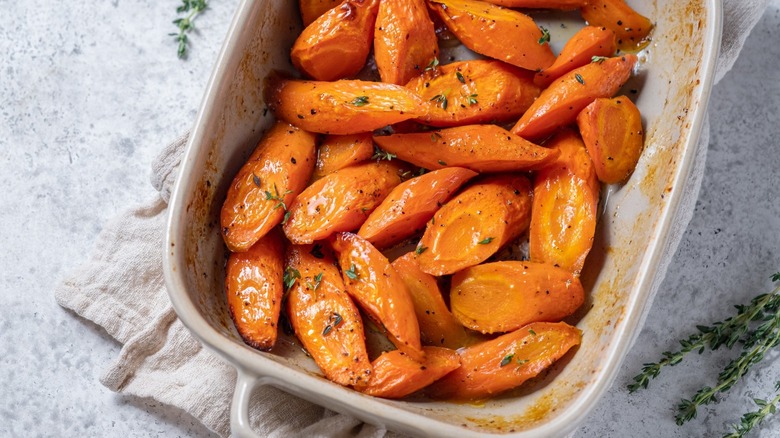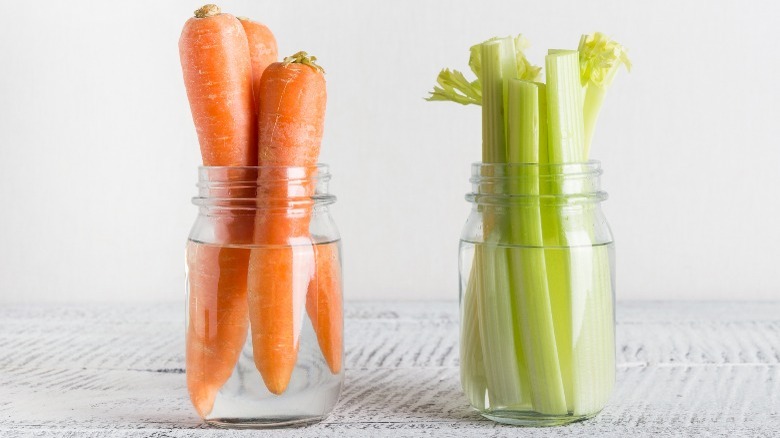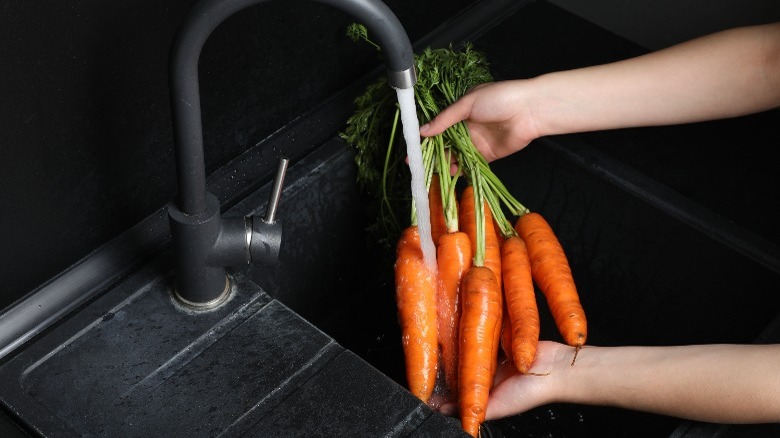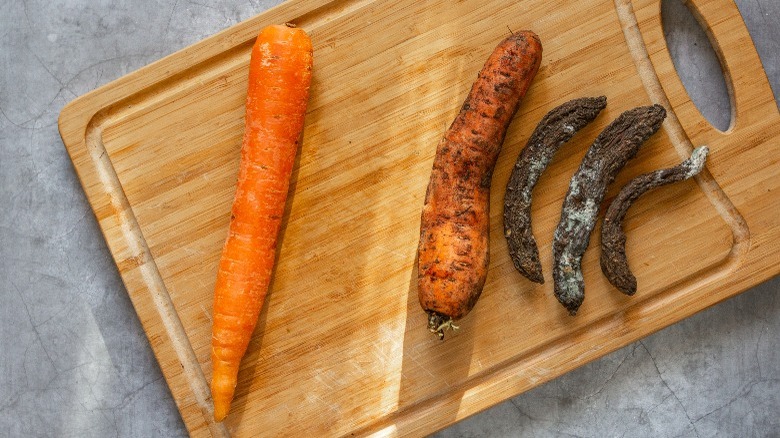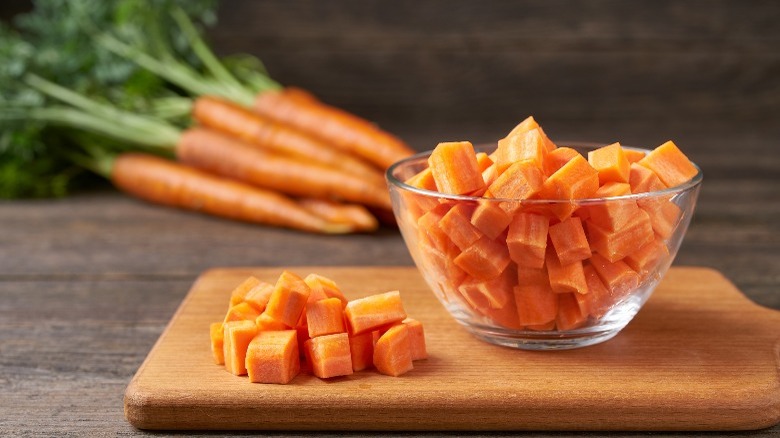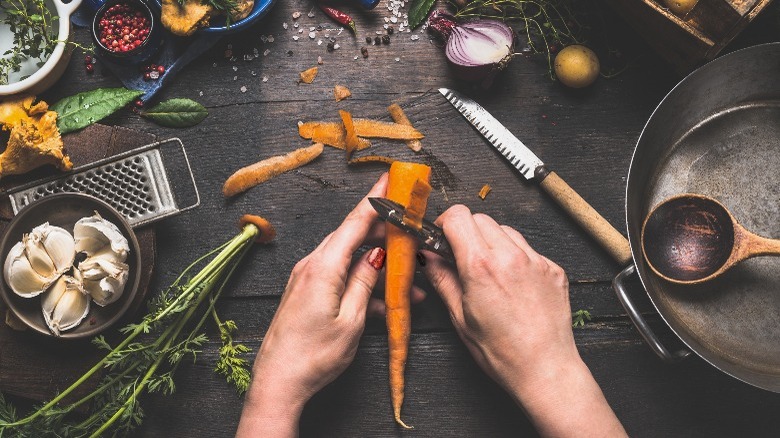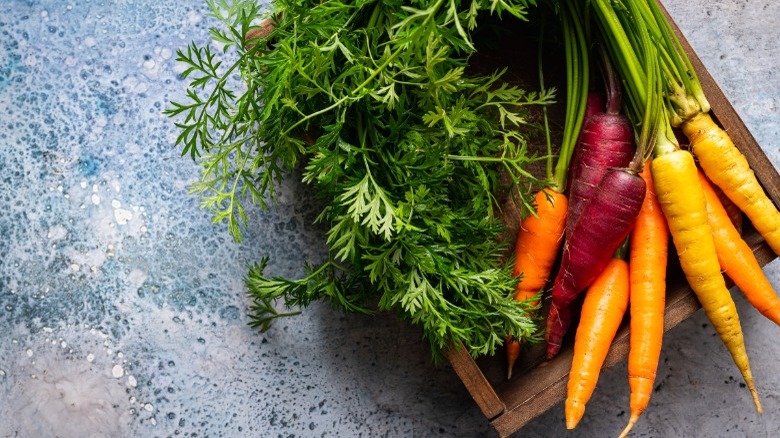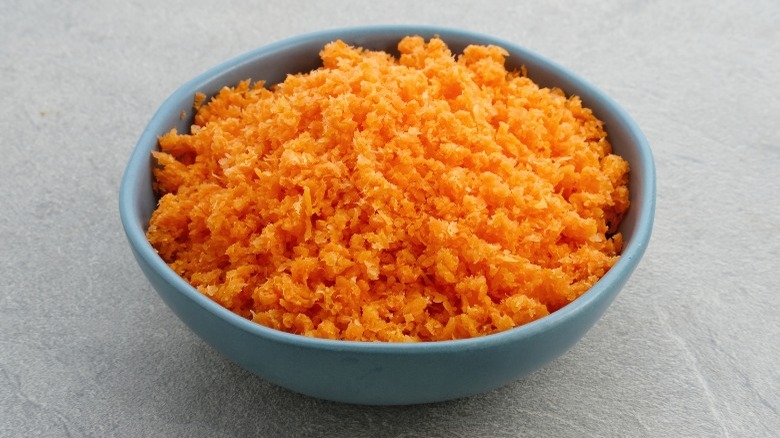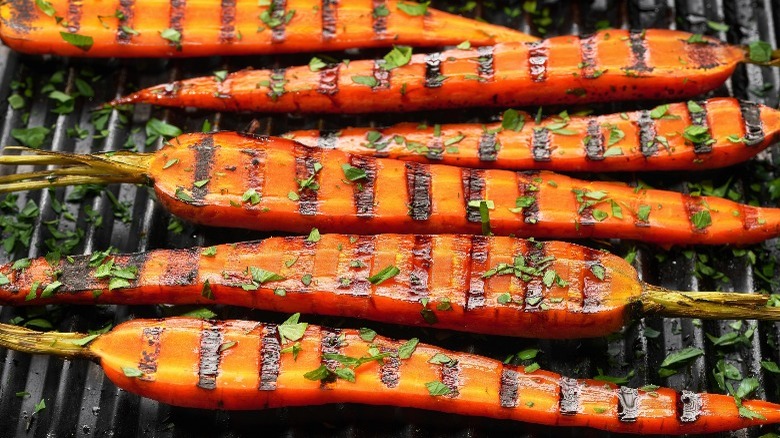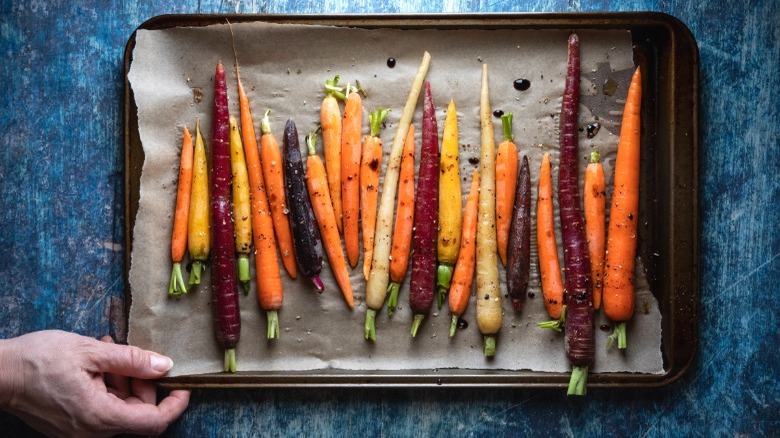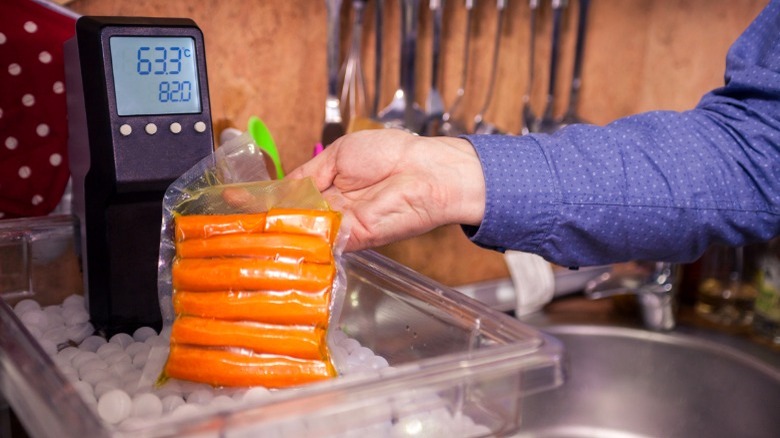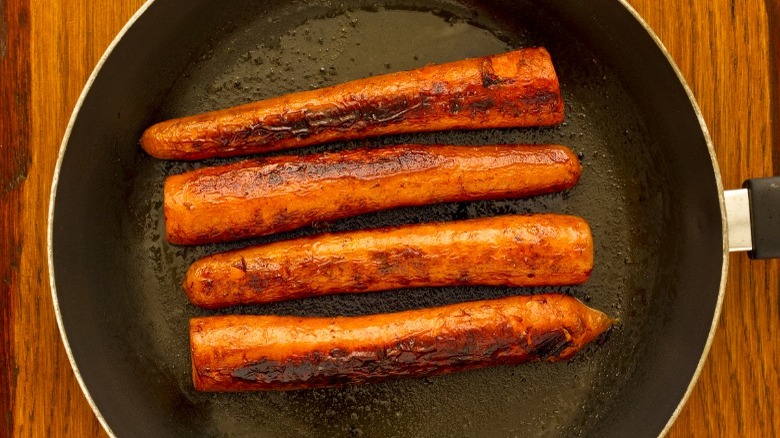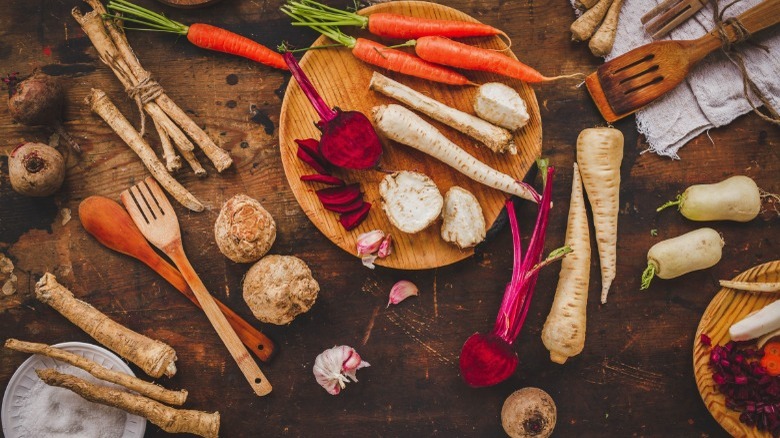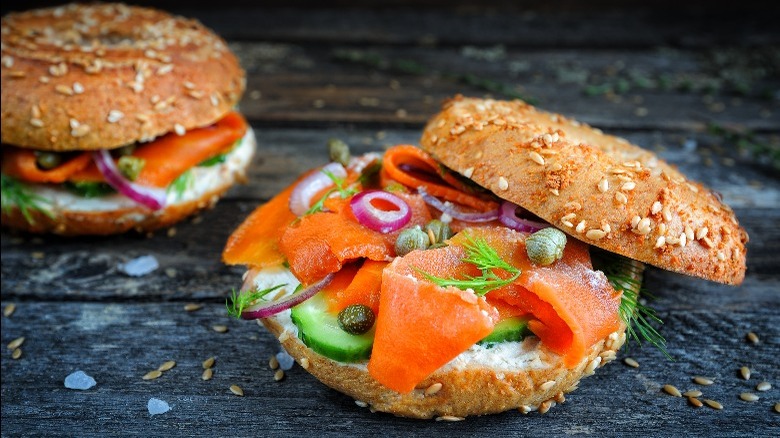14 Tips You Need When Cooking With Carrots
Carrots are an incredibly versatile vegetable and a staple in many dishes. Whether adding carrots to a soup or roasting them as a side dish, these versatile, nutrient-rich veggies are an excellent way to make any meal healthier. Raw carrots are prized for their refreshing crunch and sweet flavor, but they can be tough to cook. Everyone wants perfectly caramelized, fork-tender carrots; however, some skill is required to avoid making them bland and mushy. While there are several ways to cook carrots, you don't need to master them all — a few key tips can take your carrot-centric dishes to the next level.
From selecting and correctly storing carrots to the most efficient ways to cook them while lowering your food waste, these tips are a surefire way to get the most flavor and nutrition. So if you want to make your carrot cooking more exciting, look no further. With the proper technique and knowledge, you can make the most of this colorful, crunchy vegetable and enjoy all its health benefits.
Store them right
Have you ever gone to grab a few crisp carrots from the refrigerator only to find them limp and shriveled? That happens because carrots lose their moisture if stored incorrectly, but a few simple actions can make them last for weeks.
The best ways to keep carrots fresh are relatively straightforward. First, give them a thorough wash but don't peel them yet. Next, cut off the greens, as they draw moisture and flavor from the root, speeding up the wilting. Store the greens separately to incorporate into other dishes. Then place the carrots into an airtight container filled with water and put them in the fridge. Change the water every few days, and they will keep good for up to a month. Peeled and cut carrots will lose their moisture even faster, so it's recommended to consume them as soon as possible. Store them wrapped in a damp kitchen towel or water bath.
Know which carrots to pick and which to avoid
Properly storing and successfully cooking poorly chosen carrots can be a challenge. When picking some up at the store, look for firm, smooth carrots with no cracks. If they are limp and flexible, they have already lost their freshness. In terms of color, the ideal carrot has a vibrant orange hue. The brighter it is, the more beta-carotene it contains, meaning more health benefits. If the carrots still have the green tops, ensure they are not wilted or discolored.
Some carrots might fit the description but are best left at the store. The ubiquitous horse carrots are one example. While it might be tempting to buy these large, thick carrots in hopes their size equals better value and less prep, try not to. They are usually high in starch and water levels, yet there's not as much flavor or sweetness as you'd expect from a carrot this size.
When it comes to carrots, bigger doesn't mean better, but what about smaller ones? There are several reasons you should never buy precut fruits and veggies, including baby carrots. They cost more and lose some nutritional value because they are cut down from big mature carrots. Fresh young carrots are great, but baby carrots aren't the best choice.
Skip the peeler
Despite what we've been taught, you can probably stop peeling carrots — even if they are dirty or "hairy." You can save time, energy, and valuable nutrients by skipping this step. A good scrub is all you need to get rid of the dirt and those occasional white "hairs," which are actually small roots. Unpeeled carrots work well in roasted vegetable dishes and soups, preserving the moisture inside and giving them a rustic look.
Another reason to leave the skin on is related to nutrition. According to Healthline, unpeeled fruits and vegetables have more vitamins, minerals, and antioxidants, as many of those nutrients are packed into the skin. Plus, there's the additional fiber you don't want to miss out on, which can help you feel satiated longer. Therefore, you can increase your nutrient intake if you leave the skins on. So next time you're cooking with carrots, give your peeler a break and keep the nutrients in.
Know what to toss and what to keep
Ever wondered what to do with a carrot that's disappointingly limp, a tad moldy, or covered in strange white fuzz? Your first thought might be to toss it, but that's not always the answer. Not every off-looking carrot is a lost cause, and here is how you can tell which ones can be saved.
First, let's take a closer look at the most benign form of discoloration: the white stuff on the surface of baby carrots (or any other form of precut carrots, for that matter). Also known as "carrot blush," this natural phenomenon signals that your carrots are simply losing moisture and should be eaten soon. Simply give them a brief cold water bath to bring back the appealing orange hue. Slightly limp carrots that show no signs of mold can be saved much the same way, restoring their brand-new crunch.
Finally, if you spot a bit of mold on your carrots, don't let the feeling of disgust overcome you. Some moldy carrots are actually safe to eat. Their density hinders mold from infiltrating deeper tissue. To ensure your safety, you should cut at least one inch below and around any moldy areas. Discard the moldy patches and cook as usual.
Maximize carrots' health benefits
We've been told to eat carrots to enhance our vision since we were kids. But unlike a lot of food myths we grew up with, this one is, in fact, accurate. Carrots are good for your eyes because of their high levels of beta-carotene — a compound responsible for their bright orange color that is converted into vitamin A by our bodies. Vitamin A, in turn, positively affects our vision, immune system, and development. Healthline also notes that carrots are rich in antioxidants and other nutrients, such as biotin and potassium, as well as vitamins B6 and K1.
So we can see that carrots are really healthy. Unlike most vegetables, however, carrots cooked carrots are more nutritious than raw carrots. That's because raw carrots are tough to digest, but cooking them is a great way to help our bodies take in more beta-carotene (via Journal of Food Science and Technology). What's more, cooking unpeeled carrots can enhance it even further. So while snacking on a raw carrot now and then is good for you, incorporating more carrots into your cooking is even better.
Use up the whole carrot
As food waste remains a global issue, concepts like root-to-stalk cooking are gaining traction to counter this problem on an individual level. Changing your habits might be challenging at first. Still, if you move at a comfortable pace, you can reduce your food waste while saving money and maximizing nutritional intake. This principle can be easily applied to the humble carrot, every part of which is edible.
If you do peel your carrots, don't throw them out. There are several creative ways to use carrot peelings in your kitchen, from chips and garnishes to pesto and soups. If you don't want to eat the skin, use it to make delicious stock or broth by boiling it down with some aromatics — it's an excellent base for soups and sauces.
It's also time to stop throwing away your carrot tops. For one, carrot greens are rich in vitamin C and have a complex, earthy flavor. They're a great addition to salads and will overhaul your pesto. Carrot tops, in turn, are the kind of veggie scrap that can be regrown. Cut off about an inch of the carrot's thicker end, place it in a shallow dish with water, and leave it on the windowsill. In a few days, it will come alive with baby carrot greens.
Experiment with different varieties
Today, carrots are synonymous with their vibrant orange hue, but that wasn't always the case. Just a few centuries ago, carrots were mostly purple. However, modern carrots are primarily orange, thanks to the 17th-century Dutch farmers who painstakingly modified purple carrots. Fortunately, other carrots did not go extinct, and these days you can buy heirloom varieties at farmers markets and high-end grocery stores.
The color can tell you about a carrot's flavor. The differences between various cultivars are subtle but still notable. White and yellow carrots can sometimes be sweeter than orange ones, enhanced by delicate herbal undertones. They would make an excellent substitute for baking. On the contrary, purple carrots have a spicy flavor profile, while red carrots have a flavor akin to orange carrots with a hint of earthiness. These would work well in vibrant salads or as pickles. So whenever you see rainbow carrots, grab some, and don't be afraid to use them.
Reuse carrot juice pulp
While it's all too common, carrot juice pulp is one of those foods you should probably stop throwing out. For one, it contains most of the vegetable's fiber, as well as lots of leftover nutrients. Considering most Americans get a shockingly low amount of fiber from plants (per University of California San Francisco), incorporating carrot pulp into your diet seems like a healthy idea.
Because of its sweet flavor, carrot juice pulp can easily be reused to enhance other dishes. For instance, you can mix it with some seeds and spices, dehydrate it and turn it into healthy snack crackers. Alternatively, you can take it as is and add it to baked goods like muffins, loaf cakes, waffles, and pancakes. It will provide subtle sweetness and moisture. Finally, if you're more into savory recipes, try adding carrot pulp to your pasta sauce or turning it into meatless balls.
Precook them before using in recipes
Carrots are much denser and starchier than many other vegetables, so it can take a while for them to cook. If you've tried grilling or roasting raw carrots alongside other vegetables, you've surely noticed this. The solution is precooking. Specifically, parboiling, steaming, or braising — three methods that cook the carrots to various degrees. This might sound like extra work (because it is), but the results are worth it.
To parboil carrots, place equally sized pieces in a pot of salted boiling water and cook for five minutes. Steaming can be done in a microwave: just put them in a container with a splash of water, and cook for six to eight minutes or until tender. Braising carrots is the best way to get them grill-ready: add them to a hot, greased pan alongside water or other cooking liquid, and let simmer until tender. Parboiling will soften them and help them cook faster in soups and stews, while steaming and braising will allow them to caramelize without burning.
Alternatively, after you precook your carrots, mix them with oil, salt, and pepper and freeze them. Then, when you're ready to cook, you'll only need a few minutes to have a delicious side dish. And if you're looking to deepen the flavor of soups, roast your precooked carrots first to develop a nice caramelized surface and rich flavor.
Combine them with vinegar
Vinegar and other acidic ingredients are known for bringing out the best in different dishes and drinks. They are essential to creating flavorful dishes, providing a vibrant, fresh taste and complementing other flavors. Vinegar can also bring balance to bitterness or sweetness. Finally, they can be used to preserve foods. What does all of this have to do with carrots, you ask?
For starters, roasted carrots become far more flavorful once you add a splash of vinegar to your go-to seasoning mix. Its acidity evaporates in the oven, and what's left is a mild yet noticeable flavor kick that's both sweet and savory. If you enjoy the tang, you can pair carrots with vinegar to make spicy cauliflower and carrot pickles. Packed with flavor from chile flakes, toasted mustard seeds, and olive oil, this recipe is even more fun if you make it with rainbow carrots. Finally, real vinegar enthusiasts can make their own carrot shrub by blending apple cider vinegar, sugar, cardamom, and carrot and using it in a flavorful mescal cocktail.
Keep cooked carrots fork-tender
Many people have a disdain for carrots whose texture isn't just right. Of course, the definition of "just right" varies. Typically, that means "fork tender" — not as hard as a raw carrot, but not as soft as a boiled one. You want a cooked carrot to have a slight bite to it yet not fall apart in your mouth. How can you achieve this?
One way to go about it is to sous vide carrots. This involves vacuum-sealing your carrots in a plastic bag and slow-cooking them in a water bath. The undeniable benefits of this method include preserving as much flavor, color, and nutrition as possible while maintaining a perfect texture.
Sous vide might be the best way to cook carrots, but not everybody can do it at home. Fortunately, there are more accessible cooking methods to keep your veggies tender-crisp. Blanching takes the least time, as you only need to keep carrots in boiling water for a couple of minutes. However, it results in carrots closer to "crisp" than "tender." Steaming takes a little longer, and you must keep an eye on your veggies to avoid overcooking them. Finally, sautéing might be your best bet, as it actively involves your senses and produces the most flavorful results. Just cut your carrots into uniform pieces, add them to a hot, greased pan in small batches, and watch them caramelize to perfection.
Let them develop a crust or a char
Raw carrots contain almost 5 grams of natural sugars per 100 grams of their weight, per USDA. Compared to sweet potatoes, red bell peppers, and even onions, that's not a lot. Yet it still allows them to caramelize properly during cooking without extra help. If your main issue with cooking carrots is that they come out bland or plainly sweet, we suggest you take advantage of this carrot feature and experiment with browning, glazing, and even charring them. You wouldn't believe how good burnt carrots can be!
To enhance the caramelized flavor, pair them with a sweet glaze. It can be as simple as a mix maple roasted carrot recipe that brushes maple syrup and butter onto the carrots before roasting. Alternatively, mix liquid sweetener, soy sauce, garlic, ginger, and crushed red pepper, then brush it onto the vegetables right before they finish cooking. You'll end up with a glossy, umami-packed caramelized layer on top of your carrots that will take them to the next level.
Learn good carrot substitutes
If a recipe calls for carrots and you're out, there is no need to worry. The art of mindful substituting can help. No ingredient is irreplaceable, and carrots are no exception. Depending on what role carrots play in a dish, you can use another vegetable in its place. Ask yourself whether carrots are in a recipe to provide crunch, sweetness, or moisture, and substitute accordingly.
A safe bet is to go for other root vegetables such as turnips, beets, or daikon. Parsnip, in particular, makes a great substitute because not only does it look like a carrot's pale cousin, it cooks like it too. The flavor is the main difference between carrots and parsnip — the latter is more herbal, with notes of cinnamon and nutmeg. Considering it was also once used as a sweetener, parsnip is an excellent substitute for carrots when baking. Zucchini is also a good choice for baked goods because it provides moisture and delicate flavor. For soups and savory dishes that rely on the carrot's sweetness and color, go with your favorite squash. Finally, celery and cucumbers make an excellent replacement for carrots in salads and juices.
Get creative with carrots
Carrots aren't just for slaw or cake — this humble vegetable has serious culinary potential. There are plenty of exciting ways to incorporate carrots into your diet beyond a sheet pan vegetable roast or a puréed soup. Sure, some of them might be a bit more complicated than your everyday carrot meals, but that doesn't mean you shouldn't try them once.
Those trying to cut down their food waste and embrace the root-to-stalk cooking style should look no further than this carrot linguine recipe. The pasta gets its color from being cooked in flavored carrot juice, which is reduced to a sauce. Additionally, it's topped with quick homemade carrot pickles and carrot top pesto. Vegan carrot lovers should experiment with umami-packed homemade carrot bacon and born-for-bagels carrot lox recipes. Finally, if you're trying to sneak more carrots into your diet, air fryer carrot fries might do the trick. Let your imagination run free, take the time to test some creative ideas out, and you'll be eating more deliciously cooked carrots in no time!
